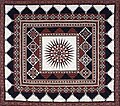English paper piecing: Difference between revisions
Removing content about a person of questionable notability, sourced only to her own web site, and put into the article by an editor who appears to have a conflict of interest. |
Citation bot (talk | contribs) Removed proxy/dead URL that duplicated identifier. | Use this bot. Report bugs. | Suggested by Abductive | Category:Quilting | #UCB_Category 34/49 |
||
| (26 intermediate revisions by 20 users not shown) | |||
| Line 1: | Line 1: | ||
[[File:English_paper_piecing.jpg|thumb|Star shapes made by paper piecing]] |
|||
'''English paper piecing''' is a method of attaching and stabilizing pieces of fabric together, based on [[foundation piecing]].<ref>{{cite web|title=The History of Modern Foundation Piecing|url=http://www.quilterbydesign.com/lessons/paper_piecing_history.html|website=www.quilterbydesign.com}}</ref> The practice's name comes from the fact that it was, and still is, popular in Britain. The technique used to paper piece involves wrapping paper shapes in fabric and then stitching the fabric together. Once a shape, bloc, rosette, or finished piece has been made, the papers are removed, leaving the fabric as the remaining item. The technique has been dated back to January of 1889 and when the papers had been left on.{{huh?|date=January 2017}} |
|||
English paper piecing is a method of patchwork where fabric is wrapped around fabric shapes made of thin paper cardboard or heavy paper. Once the shapes are wrapped and ready, the sewer will hand sew the shapes together one at a time until the shapes become an intricate design. The paper or cardboard is removed once the shape has been sewn to another shape on all sides. This is an art for those who like to sew by hand. |
|||
The practice's name comes from the fact that it originated in England in the 1770s.<ref>{{Cite web |title=What is English Paper Piecing - How it's done and its history {{!}} European Quilting Supplies |url=https://www.eqsuk.com/news/consumer/what-is-english-paper-piecing-how-it-s-done-and-it-s-history/226 |access-date=2023-03-04 |website=www.eqsuk.com}}</ref> Once a shape, bloc, rosette, or finished piece has been made, the papers are removed, leaving the fabric as the remaining item. |
|||
[[Carol Doak]] was known for being one of the modern teachers at the 1992 [[Quilt Festival]], though not{{huh?|date=January 2017}} her now popular foundation piecing classes of today. Doak's book, ''Easy Machine Paper Piecing: 65 Quilt Blocks for Foundation Piecing'' has sold over 127,000 copies worldwide. She helped to coin the term "paper piecing" from the root of "paper foundation piecing". |
|||
[[File:Patchwork pieces (AM 17441-3).jpg|thumb|243x243px|Backside of fabric pieces, shaped into hexagons by pieces of paper]] |
|||
English paper piecing should not be shortened to "paper piecing", as that term includes [[Foundation piecing|Foundation Paper Piecing]] (which uses a sewing machine to sew the fabric shapes together along lines on the paper) as well, nor should the two distinct paper piecing techniques be confused with each other.<ref>{{Cite journal |last1=Leake |first1=Mackenzie |last2=Bernstein |first2=Gilbert |last3=Davis |first3=Abe |last4=Agrawala |first4=Maneesh |date=2021-07-19 |title=A mathematical foundation for foundation paper pieceable quilts |journal=ACM Transactions on Graphics |volume=40 |issue=4 |pages=65:1–65:14 |doi=10.1145/3450626.3459853 |issn=0730-0301|doi-access=free }}</ref> |
|||
== References == |
== References == |
||
{{reflist}} |
{{reflist}} |
||
== External links == |
|||
* [https://books.google.com/books?id=sKNKEAAAQBAJ Flossie Teacakes' Guide to English Paper Piecing - Google Books] |
|||
{{Layered textiles}} |
|||
[[Category:Quilting]] |
[[Category:Quilting]] |
||
Latest revision as of 09:12, 9 February 2024

English paper piecing is a method of patchwork where fabric is wrapped around fabric shapes made of thin paper cardboard or heavy paper. Once the shapes are wrapped and ready, the sewer will hand sew the shapes together one at a time until the shapes become an intricate design. The paper or cardboard is removed once the shape has been sewn to another shape on all sides. This is an art for those who like to sew by hand.
The practice's name comes from the fact that it originated in England in the 1770s.[1] Once a shape, bloc, rosette, or finished piece has been made, the papers are removed, leaving the fabric as the remaining item.

English paper piecing should not be shortened to "paper piecing", as that term includes Foundation Paper Piecing (which uses a sewing machine to sew the fabric shapes together along lines on the paper) as well, nor should the two distinct paper piecing techniques be confused with each other.[2]
References
[edit]- ^ "What is English Paper Piecing - How it's done and its history | European Quilting Supplies". www.eqsuk.com. Retrieved 2023-03-04.
- ^ Leake, Mackenzie; Bernstein, Gilbert; Davis, Abe; Agrawala, Maneesh (2021-07-19). "A mathematical foundation for foundation paper pieceable quilts". ACM Transactions on Graphics. 40 (4): 65:1–65:14. doi:10.1145/3450626.3459853. ISSN 0730-0301.

